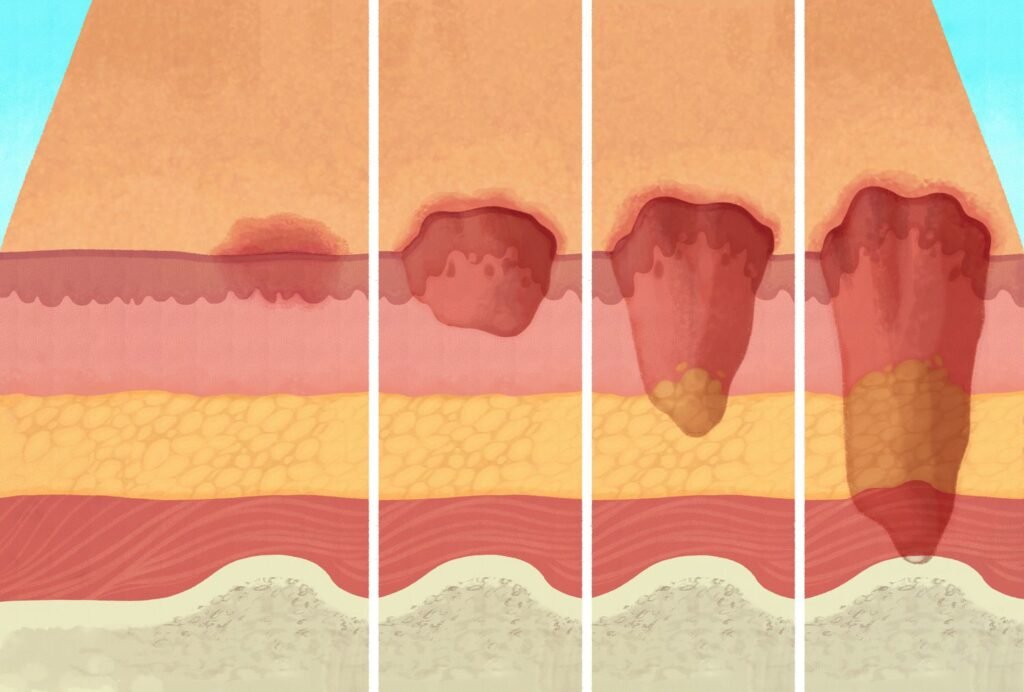What is Decubitus Ulcer and how is it Formed?
Daniel Davidson, MD, MBA, DBA, PHD Introduction: Decubitus ulcers, sometimes called bedsores or pressure ulcers, these are a frequent medical ailment that can be prevented by applying pressure to the skin. The condition arises when pressure is applied to certain areas of the body, reducing blood flow to those areas. As a result of continuous pressure on particular body parts, these ulcers usually develop in people who are confined to a bed or chair for extended periods of time. Formation of Decubitus Ulcers: Long-term pressure on the skin causes reduced blood flow to the affected area, which can result in decubitus ulcers. A prolonged period of pressure applied to the skin may harm the tissue beneath it. Tissue damage and ultimately the development of an ulcer are caused by the absence of blood flow, which deprives the tissue of nutrients and oxygen. Pressure: Pressure on the skin is the main factor contributing to decubitus ulcers. Blood flow is restricted to a certain place of the body when pressure is applied there for a prolonged amount of time. Ischemia: Also referred to as restricted blood flow, ischemia causes the affected tissue to lose vital nutrients and oxygen. Consequently, the tissue starts to die, causing harm to other tissues and ultimately the development of an ulcer. Friction and Shear: Besides pressure, decubitus ulcers can also develop as a result of friction and shear. Shear happens when tissue layers move against one another, whereas friction happens when the skin brushes against a surface. These pressures have the potential to further deteriorate the skin and underlying tissue, increasing the risk of ulcer development. Skin Breakdown: The skin and underlying tissue sustain damage as a result of continuous pressure, friction, and shear. A pressure injury may first show signs of redness or discoloration of the skin. An open sore or blister may develop if the pressure continues to build up on the epidermis, the skin’s outermost layer, and a portion of the dermis, the skin’s underlying layer. Ulcer Formation: Should the pressure remain unchanged, the ulcer may go through the following stages: Stage 1: Only the skin’s outermost layer is affected by the superficial ulcer. To the touch, the skin could appear heated, discolored, or red. Stage 2: An open sore or blister is formed as the ulcer spreads into the skin’s deeper layers. Stage 3: The tissue under the skin is harmed when the ulcer spreads into the subcutaneous layer. Stage 4: The worst stage, in which the ulcer penetrates deeply into the tissue and affects the bone, muscles, and tendons. Risk Factors: The following are some of the variables that can raise the risk of decubitus ulcers: Immobility: Those who are confined to a wheelchair or are bedridden are more vulnerable. Reduced mobility: Individuals who have restricted movement, such as those recuperating from injuries or surgeries, are also vulnerable. Inadequate nutrition: The body’s capacity to heal injured skin may be hampered by a diet deficient in important nutrients. Incontinence: Skin breakdown is more likely when there is an excessive amount of moisture in the urine or feces. Age: Because their skin is thinner and their mobility is limited, older persons are more likely to get decubitus ulcers. Prevention and Treatment: Avoidance: Frequent Position Changes: Changing postures on a frequent basis is one of the best strategies to avoid decubitus ulcers. Those who are confined to a wheelchair or bed can reduce pressure on sensitive body parts by switching positions every two hours. Utilization of Support Surfaces: Pressure ulcer risk can be decreased and pressure can be distributed more uniformly with the use of specialized mattresses, cushions, and padding. These support surfaces lessen strain on the body’s susceptible parts, such as bony prominences. Sustaining Proper Nutrition: In order to keep skin healthy and stop pressure ulcers from developing, a balanced, healthful diet is crucial. Sufficient consumption of protein, vitamins, and minerals is especially crucial for fostering tissue regeneration and averting skin deterioration. Skin Care: The prevention of decubitus ulcers depends on maintaining clean, dry skin. Regular skin hydration can reduce the possibility of dryness and cracking, which raises the danger of skin damage. Maintaining dry and clean skin is especially crucial when incontinence is a problem. Preventing Friction and Shear: These two factors raise the possibility of pressure ulcer development and skin deterioration. Those who are bedridden or wheelchair-bound should be moved or repositioned carefully to prevent dragging or tugging the skin. Treatment: Relieving Pressure: Relieving pressure on the affected area is the initial step in treating decubitus ulcers. This can entail often shifting positions, applying support surfaces like orthopedic mattresses or pillows, and avoiding applying pressure to the afflicted area. Wound Care: To encourage healing and stave off infection, the wound must be kept clean and moist. To encourage healing, wounds should be cleansed with a mild cleanser and dressed with moisture. Debridement: To remove dead or necrotic tissue from a wound and encourage healing, debridement may be required in some situations. There are a number of techniques for debridement, including as autolytic, enzymatic, and sharp debridement. Bandages and Dressings: Covering a wound with bandages or dressings can aid in healing and shield it from additional harm. Depending on the kind and severity of the wound, there are several types of dressings available, such as foam dressings, alginate dressings, and hydrocolloid dressings. Pain control: Because decubitus ulcers can cause excruciating pain, it’s critical to provide patients with appropriate pain control in order to enhance their comfort and overall health. To treat pain brought on by decubitus ulcers, physicians may prescribe painkillers in addition to non-pharmacological therapies including wound care and posture. Conclusion: A common, but potentially dangerous, medical disease known as decubitus ulcers can arise when pressure on the skin inhibits blood flow to particular parts of the body. People can lessen their chance of getting these excruciating and possibly fatal sores by learning the causes and risk factors of decubitus ulcers and taking preventative approaches. For the purpose of avoiding problems and











